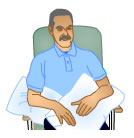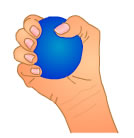
- Get Advice Ask therapist for advice on what you can do to help.
- Take care of the arm Encourage the person to care for their arm by not allowing it to drag or dangle down at their side.
- Support on pillows Support the arm with pillows when sitting or resting.
- Do your exercises Encourage the person to care for their arm by following exercises they have been given.
- I could help Once you have been given instruction you may be able to assist with exercises, gentle stretches and massaging the hand.
- Underarm hygiene Try to make sure hand and underarm are washed and dried thoroughly and regularly.
- Encourage gentle movement If the person has some functional use in the arm encourage them to use the movements they have as much as possible.
- Wear a splint/ sling If the person has been given a splint or sling make sure you know how it is to be worn and used and encourage the person to use as instructed.
|

- Give the arm a pull Don’t pull on the arm, it could cause pain or further damage.
- Use weights You should not use weights or stretch the persons arm without asking a therapist if this will help or without being shown the correct method of stretching by a therapist.
- Squeeze a soft ball Do not give a ball to the person to squeeze without checking with the therapist first. This is not appropriate for all stroke patients and may encourage the hand to become tighter rather than to open for every day tasks.
- No pain- no gain Don’t keep pushing the person to do exercises all the time. They may be tired or in pain. Too much exercise or the wrong exercise could make things worse. Try to keep to the exercises recommended by the therapist. If you are concerned or unsure ask.
|